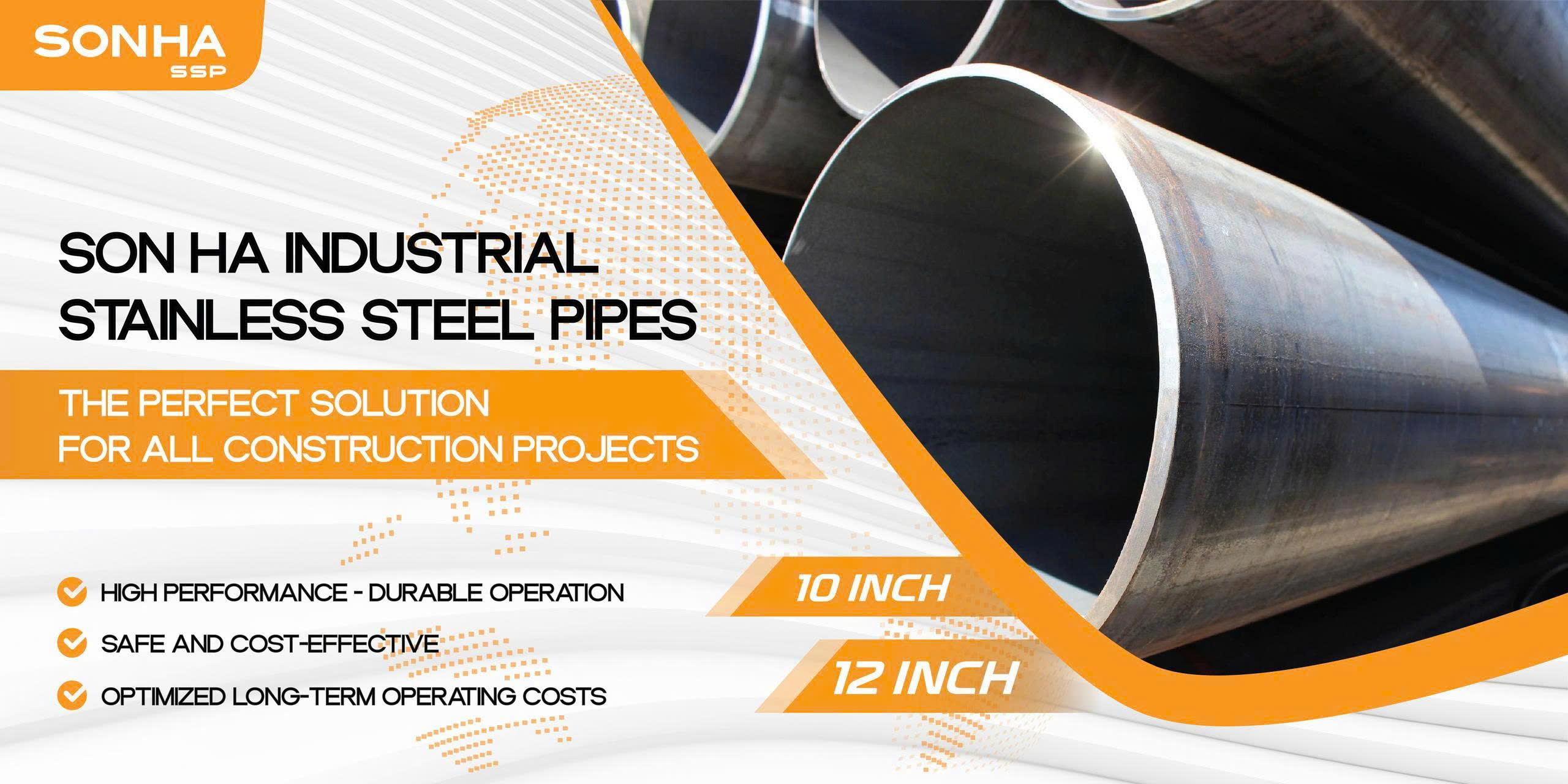What are Steel Coils? Popular Types of Coiled Steel
In the construction industry, steel coils are an indispensable material that plays a crucial role in all projects, from residential to heavy industrial. However, not everyone fully understands what steel coils are, how many types there are, and how each type is applied. The following article from Son Ha SSP will provide you with a general overview of popular types of coiled steel.
What are Steel Coils?
A steel coil is a collection of thin steel sheets, with either a smooth or ribbed surface, that are rolled up together. Depending on the type and purpose, the thickness of a steel coil can range from 0.125 to 4.5 mm, and each coil typically weighs between 0.2 and 0.45 tons, though it can reach up to 20 tons in some special cases.
This type of steel is widely used in both the construction and mechanical engineering industries. Its production requires modern refining and rolling technology to ensure product quality. Steel coils are categorized by type and surface treatment methods to meet the diverse application needs across different sectors.
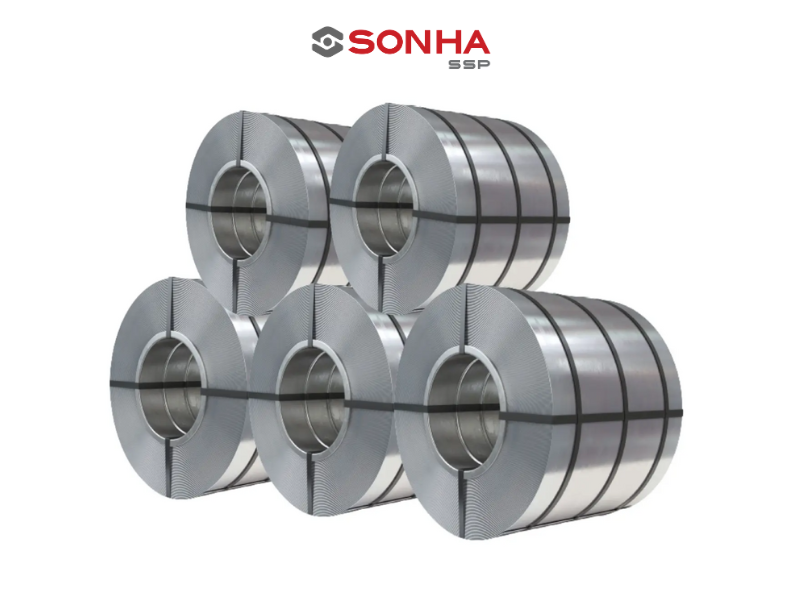
A collection of thin steel sheets with a smooth surface that are rolled up together
2. Popular Types of Steel Coils
The market currently offers many types of coiled steel, each with its own unique features and applications. Here are some of the most popular types:
2.1. Hot-Rolled Coils
Hot-rolled coil (HRC) is a product created by hot rolling a steel billet at temperatures above 1,000°C. Hot-rolled coils are typically thick, usually over 1.2 mm, with a width ranging from 600 to 1,500 mm. Because they are processed at high temperatures, hot-rolled coils have a slightly rough, bluish-grey surface. The main advantages of this type are its low cost and high durability.
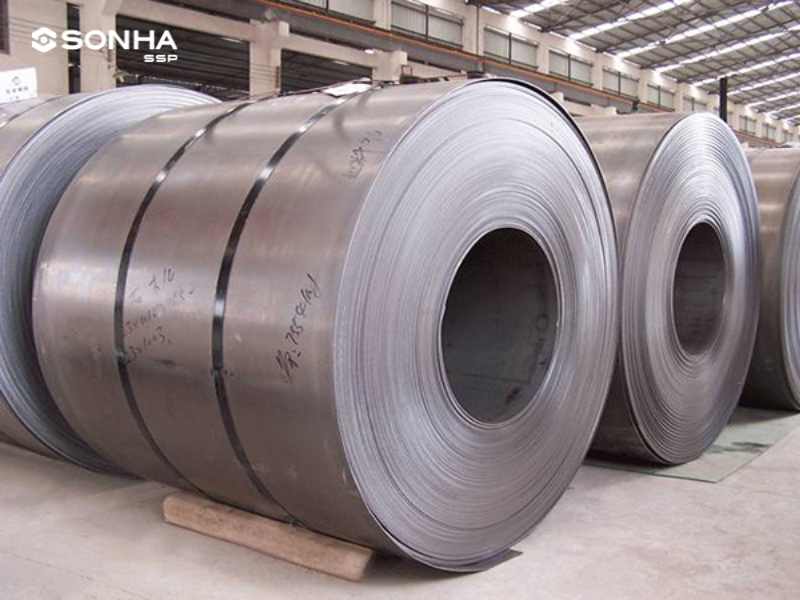
Characteristic gray hot-rolled steel coil
Hot-rolled steel is primarily used as a raw material for many other products, including:
- Cold-rolled coils
- Welded pipes
- Seamless pipes
- Other applications: Used for roofing sheets, railway tracks, pipe fittings, car frames, and construction components.
2.2. Cold-Rolled Steel Coils
Cold-rolled coil (CRC) is a product made from hot-rolled steel coil that has been “cold-rolled.” This means its temperature is gradually lowered while it passes through rolling mills to reduce its thickness, resulting in a very smooth, bright surface. This process changes the steel’s shape but not its material structure, so it retains high durability and good aesthetics. It typically has a thickness of 0.15–4 mm and a width of 600–1,250 mm.
Cold-rolled steel has a bright white surface, sharp edges, and higher aesthetic appeal. Due to its good load-bearing properties and easy workability, cold-rolled coils are used in many products that require high precision and a glossy finish, such as automotive and motorcycle parts, aircraft mechanical components, furniture (beds, cabinets, shelves), home appliances (stoves, refrigerators, washing machines), as well as mechanical machine parts (bolts, gears, etc.).
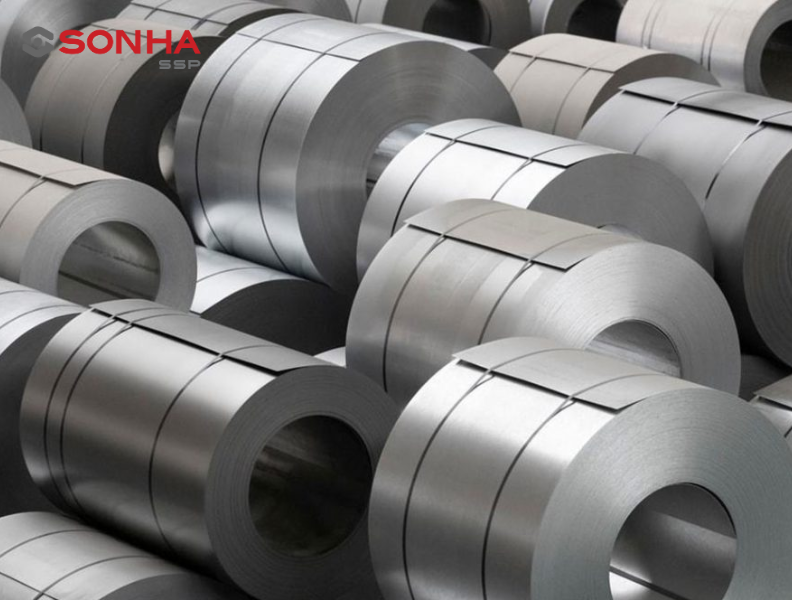
Hot-rolled coils have a smooth, shiny surface.
2.3. Galvanized Steel Coils
Galvanized steel coils are steel sheets that have been coated with a layer of zinc on the surface after being hot or cold rolled. The galvanized surface is smooth and bright, offering very high corrosion resistance. The typical thickness of galvanized steel coils is around 0.2–3.2 mm, with widths of 50–1,250 mm. Each coil can weigh between 5 and 20 tons, depending on the factory’s standards.
Thanks to their superior durability and corrosion resistance, galvanized steel coils are widely used in architectural and industrial projects for applications such as roofing sheets, pipe casings, structural frames, shipbuilding, automotive components, decorative mechanical products, and advertising signs.
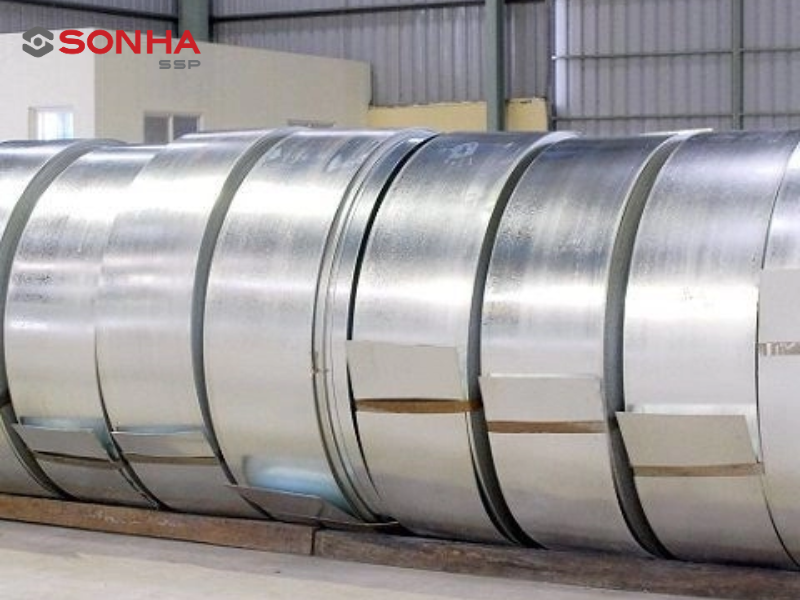
Galvanized Steel Coil
2.4. Prepainted Steel Coils
Prepainted steel coils are a type of steel sheet that is first galvanized and then coated with one or more layers of colored paint during the rolling process. Thanks to this paint layer, prepainted steel coils offer high aesthetic value and excellent corrosion resistance.
They are typically thin, with a thickness ranging from 0.14 to 1.5 mm, and each coil weighs about 3 to 5 tons. This type of coil is commonly used in residential construction (for roofing, doors, fences, pillars, etc.), civil engineering, and the manufacturing of various equipment (shipbuilding, prefabricated steel structures, electronic devices, automobiles, and household appliances).
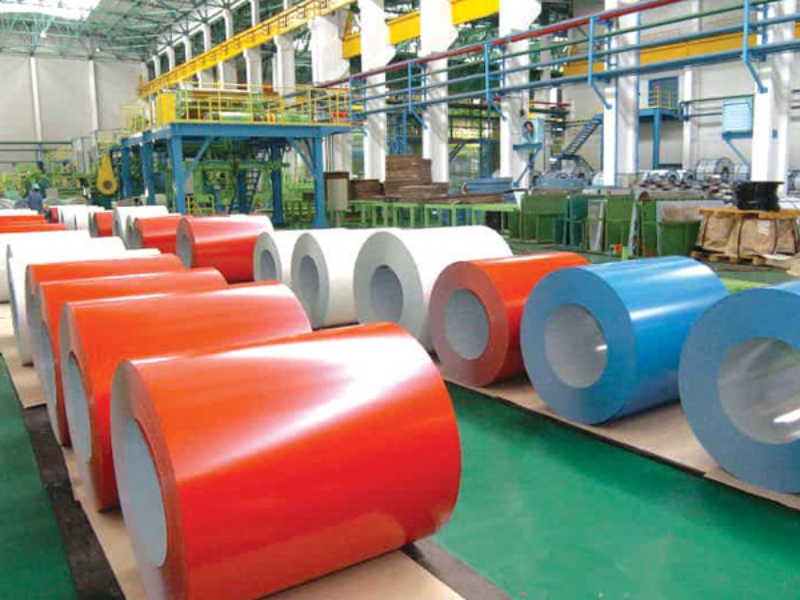
Prepainted Steel Coils
2.5. Stainless Steel Coils
Stainless steel coils are steel coils whose composition or surface has been specially treated to prevent rust, typically through a surface chroming layer or by using a stainless alloy. This type is very durable and does not oxidize in humid or chemical environments. Consequently, stainless steel coils are used in industries that demand high corrosion resistance, such as shipbuilding, chemical processing, electronics, and infrastructure projects exposed to seawater.
3. Steel Coil Production Process
The steel coil production process involves a series of continuous stages, from raw materials to the finished product. The main steps are as follows:
Step 1: Melting and Casting the Billet Iron ore, pig iron, and other additives are heated in a blast furnace or electric arc furnace until they melt. The molten steel is then cast into billets (blooms, slabs, or round billets).
Step 2: Hot Rolling The slabs are sent to a hot rolling mill. Here, they are rolled at high temperatures (around 1100–1300°C) into long sheets, which are then coiled to form hot-rolled steel coils. After this step, the steel billets are transformed into hot-rolled coils.
Step 3: Cold Rolling (if applicable) If a product requires a smooth, shiny surface and high precision, the hot-rolled coils are cooled, acid-pickled, and then passed through cold rolling lines. This process gradually reduces the steel’s thickness and increases its surface gloss.
Step 4: Surface Treatment To meet corrosion resistance requirements, the finished steel coils can be galvanized to create galvanized steel coils or coated with colored paint (for pre-painted steel coils). The galvanizing stage typically includes several technical steps to ensure the zinc layer adheres firmly and evenly to the steel coil’s surface.
Step 5: Inspection and Packaging After production, the steel coils are quality-checked for dimensions, thickness, and chemical composition according to standards. Finally, they are packaged and shipped to customers. The coils are usually secured with steel straps and protected in wooden crates or wrapped in moisture-proof paper.
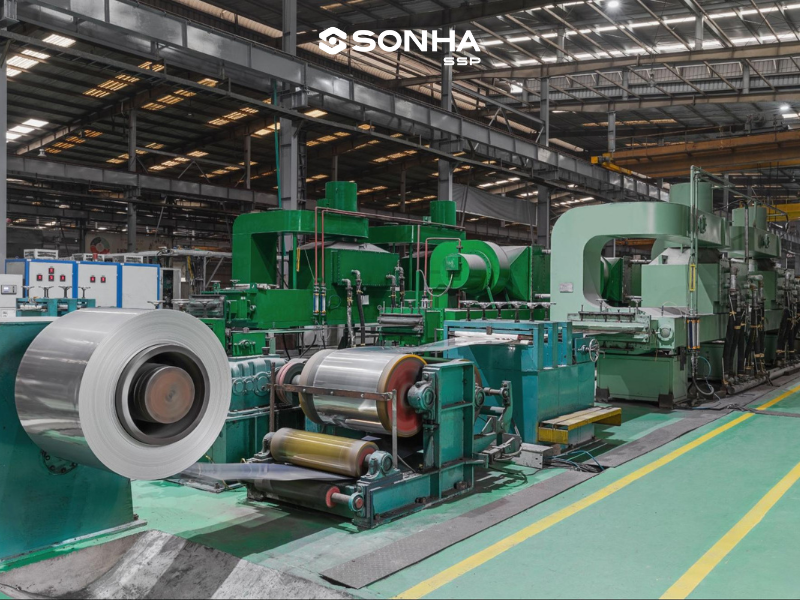
The steel coil production process involves many complex stages.
4. How much does a steel coil weigh?
The weight of a steel coil depends on its type and size. For example, small construction steel coils might only weigh about 1–2 tons each. In contrast, industrial hot-rolled steel coils are very heavy, typically weighing from 18–25 tons per coil, and can even reach 24–40 tons for some HRC coils.
For coated steel coils, a standard prepainted steel coil weighs approximately 3–5 tons, while a galvanized steel coil usually weighs 3–8 tons.
5. When are steel coils used?
Thanks to their diverse properties, high load-bearing capacity, and ease of processing, steel coils have become an indispensable material in many industrial and construction fields. Each type of steel coil has its own advantages, allowing it to flexibly meet various application requirements:
- Hot-rolled steel coils: With a strong structure and superior load-bearing capacity, hot-rolled coils serve as the foundation for many heavy industries. Key applications include manufacturing roofing sheets, car chassis and body parts, ship hulls, decks, and other large components in marine environments.
- Cold-rolled steel coils: Featuring a smooth, bright surface and high precision, cold-rolled coils are an ideal choice for products that require aesthetic and sophisticated technical elements. This includes manufacturing household items like wardrobes, door handles, aluminum window frames, and high-end metal furniture with modern, refined designs.
- Galvanized steel coils: Thanks to their effective anti-corrosion zinc layer, galvanized steel coils offer superior durability in harsh environments while maintaining a long-lasting aesthetic. They are often used in ventilation and air conditioning systems, concrete floor structures, civil construction, mechanical engineering, fire protection systems, and various electrical and mechanical components.
- Stainless steel coils: Known for their high oxidation resistance and long-term durability, stainless steel coils are the ideal material for applications requiring high quality and long-lasting strength, such as threaded rods, bolts, and pipe hangers.
In summary, each type of steel coil has specific applications based on its material properties. A correct understanding of the different types—such as hot-rolled, cold-rolled, galvanized, prepainted, or stainless steel—is the first step to ensuring a project’s quality.
>Related Posts:
Next latest post

Where Is Stainless Steel 304 Pipe Used?

Which Type of Stainless Steel Pipe Is the Best? A Guide to Choosing the Right One for Your Application

A Detailed Overview of the Characteristics and Applications of Welded Stainless Steel Pipes
